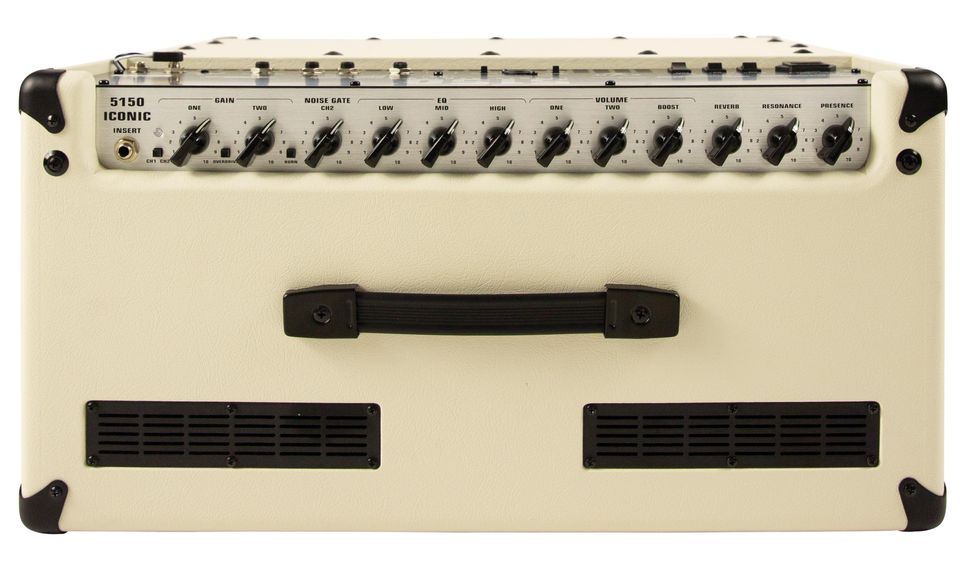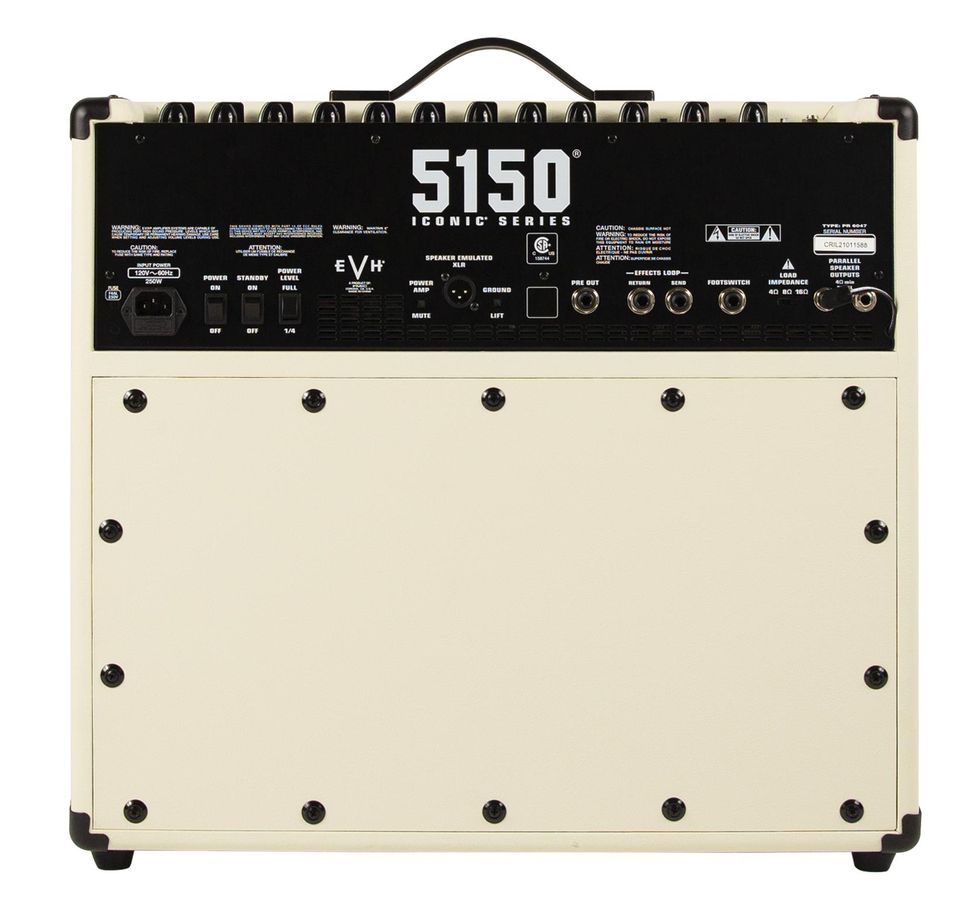The late Eddie Van Halen spent much of his early career in search of what’s now known as the “brown sound.” Years after cracking the code, he helped bottle various versions of the recipe into the 5150 line of amps. Various iterations of these amps are now studio and stage staples, and are often used in heavy genres that transcend Van Halen’s vision.
These amps have never been cheap. But the new EVH 5150 Iconic Series models offer a much more affordable take on 5150 designs and are offered in two versions: a 40W 1x12 combo that retails for a very reasonable $899 and an 80W head version at $999. For this review, we look at the 2-channel combo.
High-Calorie Combo Platter
The 5150 Iconic Combo is powered by two 6L6 power tubes, two ECC83 preamp tubes, and a specially designed 40-watt Celestion speaker, all of which are encased in a closed-back MDF cabinet for tighter, heavier bass response. Closed-back combos are slightly unusual as they are costlier to manufacture and tube cooling can be a concern. Most dedicated EVH tone chasers will probably be happy for the audible effects of the closed-back configuration, though.
The combo has a sparse, utilitarian vibe. Apart from a 5150 logo on the top left corner of the cabinet and an EVH logo affixed to the bottom right corner of the grille, there’s little to distinguish it. The controls are hidden away on the top panel. Here you’ll find gain and volume knobs for each channel, and shared controls for EQ (low, mid, high), boost, reverb, resonance, and presence. There’s also a noise gate control exclusively for channel 2. There are three mini buttons: one for channel switching and the other two for the additional presets for each of the channels.

The rear panel is home to a XLR output (with speaker emulation), a power amp mute switch, a preamp out jack, a power level switch (which lets you choose between 40W or 10W), and an effects loop. The cool thing about this loop is that you can use the return jack to bypass the preamp while the boost, reverb, resonance, and power level remain functional.
A Ton of Gain Unchained
While the 5150 Iconic is a 2-channel amp, each channel has its own switchable low-/high-gain mode, effectively giving you four different gain profiles. Channel 1 has a push button for selecting between clean and overdrive. The channel 2 mini-button, meanwhile, engages the ultra-hot “burn” voicing.
The overdrive preset of channel 1 is essentially a crunch channel, sort of like the blue channel of the 5150 III, but with slightly more gain. Even with the gain at 2, the overdrive preset is pretty distorted. Bumping the gain to just 4.5 yields tones closer to distortion than overdrive.
Channel 1’s overdrive mode ranges deep into high-gain realms and could easily be used as a “lead” channel.
Channel 1’s overdrive mode ranges deep into high-gain realms and could easily be used as a “lead” channel. Channel 2, however, is comparatively hellacious. With gain at just 2 you’ll get output roughly equivalent to channel 1’s overdrive channel with the gain at 8. With channel 2’s gain up to 7, I was well into extreme modern metal territory. But that’s just the tip of the iceberg! Channel 2’s burn mode adds even more heat and saturation, yielding ridiculous amounts of sustain. Single notes seemed to last forever, even without finger vibrato. At times it felt like an EBow at work.
With this much over-the-top gain available, it was a smart move for EVH to include a noise gate on the 5150 Iconic. The gate is helpful, but it has its limits. Even with the gate threshold at maximum, a fair bit of hum and amp noise persists at the most beastly levels.
The Best of Both Channels
If there were a way to footswitch between channel 1’s clean and overdrive sounds, the 5150 Iconic would essentially become a 3-channel amp, with clean, crunch, and lead sounds. But that would likely make the Iconic much more expensive.

In lieu of a footswitchable third channel, though, the boost function, which is footswitchable and adds up to 10 dB of volume, is one way to MacGyver a faux 3-channel setup. I got a pretty workable template using these three settings:
- Channel 1 with gain on 2 and overdrive preset selected. Guitar volume lower for a cleanish sound.
- A boosted version of that cleanish sound, with boost on 8 and guitar volume at maximum for a crunch sound.
- Channel 2 with gain high for a lead sound.
If only there were a way to get a footswitchable setup with four sounds to include the burn preset!
The Verdict
James Brown, the legendary amp designer who worked closely with Eddie Van Halen to create the original Peavey 5150 amp, was recruited by EVH in 2019 to become a principal analog engineer. He was tasked with masterminding the 5150 Iconic series. And it’s safe to say Brown succeeded.
The resulting 5150 Iconic Series 40W 1x12 is a unique amp. It can easily do the Van Halen thing. But it’s also insanely versatile and capable of sounds from clean to ultra-high gain to the most extreme molten metal. It’s also just a great all-around amp. And it’s easy to imagine the 5150 Iconic becoming ubiquitous in the manner of a Fender Hot Rod Deluxe for the heavy-music set.

















